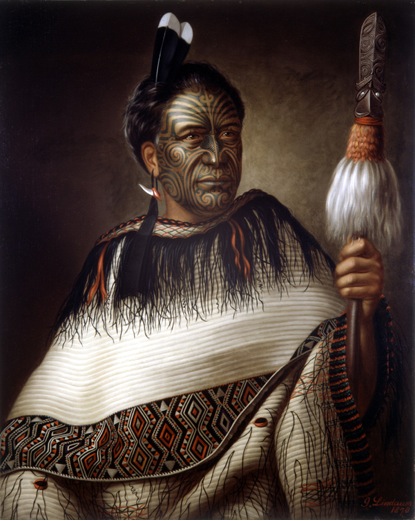Portrait of Ngairo Rakai Hikuroa
 Collected by Henry Balfour and donated by him in 1938: 1938.35.1880New Zealand, 1878
Collected by Henry Balfour and donated by him in 1938: 1938.35.1880New Zealand, 1878
This oil painting on canvas is one of more than seventy Māori portraits painted by Gottfried Lindauer (1839–1926), an artist of Czech descent who settled in New Zealand in 1873.
Ngairo Rakai Hikuroa was chief of Ngatu Kahungunu Wairarapa on the southeastern coast of the North Island. His moko is striking but is only completed by the rest of attire – huia feathers (now extinct) in his hair; a taiaha, a traditional staff weapon adorned with dog hair; a mako, an ear pendant made of a shark's tooth and red wax; and a korowai, a cloak decorated with coloured wool and flax cord tags.
Although it is possible that this portrait was done from life Lindauer was also known to work from photographs. The quest for a 'characteristic' New Zealand as reflected in the landscapes, scenes and portraits by Lindauer and his contemporaries such as Charles Goldie (1870–1940), was linked to a new kind of 'mature' colonialism and a sense of distinctive national identity that emerged in the late 19th century and was accompanied by a surge in ethnographic, artistic and historical interest in the Māori. This resulted in a shift away from 'old world' perspectives in art and literature, whilst progressive legislation led to New Zealand's eventual change in constitutional status in 1907 from self-governing colony to an independent British Dominion.
Lindauer's attention to detail allows the viewer to appreciate the intricacy of the moko design. These designs are never static, but are a dynamic form of expression in constant evolution. For example, moko's archaic form, moko kuri, did not feature swirling, spiralling lines at all, but instead mirrored more closely the facial tattoo of Marshall Islands chiefs, which consisted of fine, zigzag vertical lines on the cheeks and horizontal comb-lines on the neck. The later swirling designs created their remarkable effects by combining tattooed areas and un-tattooed areas – the 'negative space'. Today, innovative designs are being incorporated into traditional ones to again create a new generation of moko 'styles'.
Although no two moko are exactly the same, they do follow certain conventions. The face is divided in half by a vertical line down the middle, the left side for the mother, the right side for the father. Then each half is divided into eight sub-sections, which refer to specific aspects of the wearer's life from his lineage, rank and tribal affiliation to his occupational and marital status and finally, on his chin, his 'mana' (spiritual power). The shapes used are also of a type, the tight spirals known as koru, and the long sweeping lines on the forehead and around the mouth known as hahae, a word which is also used to describe the dawn – just as the moko grooves lacerate the skin, so the rays of the sun lacerate the sky.
A man may see his moko designs in his sleep but he must get them approved by an elder of his community first. The tattoo artist (tohunga) also spends time talking with the person who wishes to be tattooed about his life history and ambitions in order to design an appropriate moko. He also considers the design in relation to the wearer's facial features – such as a high hairline, large nose or deep-set eyes – to create something that is truly in tune with their individual identity.
